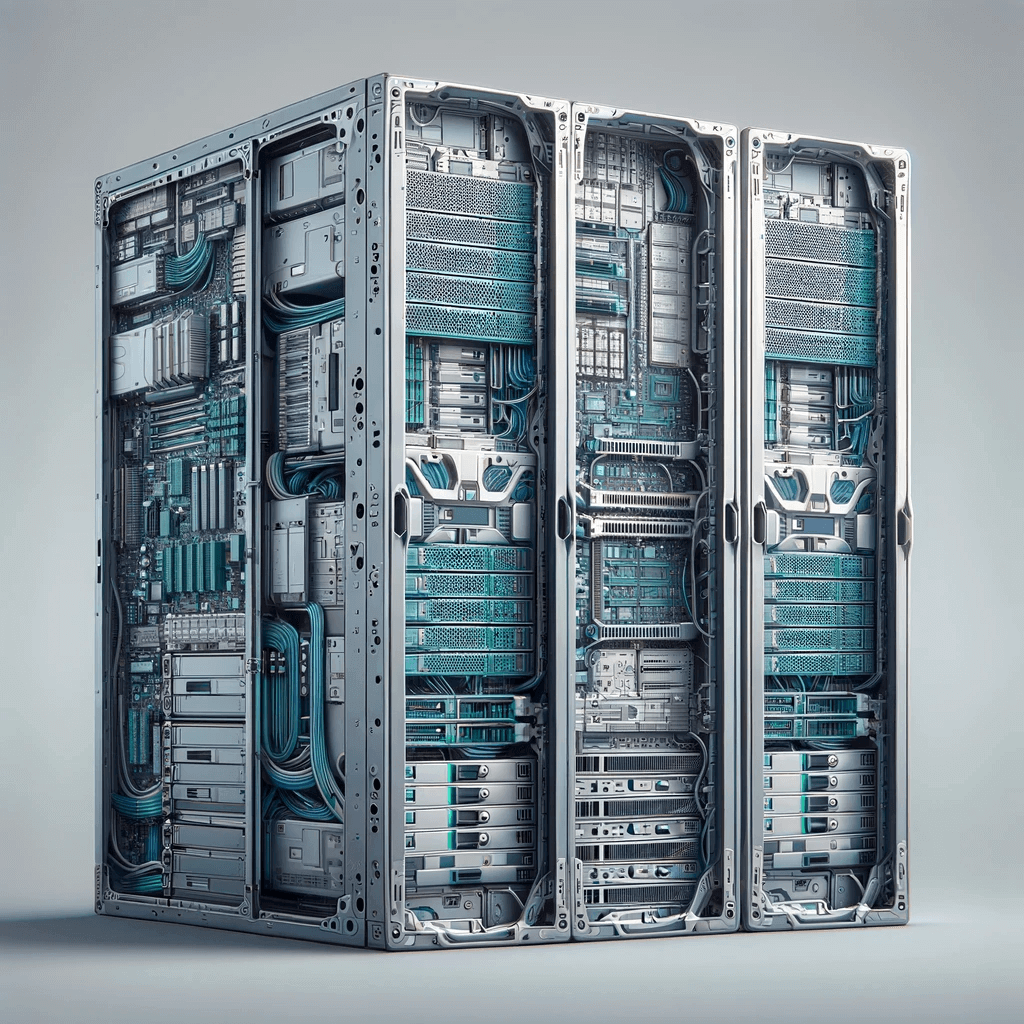What is Hyperconverged Storage
 Hyperconverged storage is a cutting-edge approach to data center management that consolidates computing, storage, and networking into a single system. This technology leverages software-defined storage (SDS) to create a flexible and scalable environment, marking a significant departure from traditional, hardware-defined systems. At the heart of hyperconverged infrastructure (HCI) lies the principle of abstracting and virtualizing the storage layer, which allows for dynamic resource allocation and management. This method not only simplifies the architectural complexity but also enhances operational efficiency.
Hyperconverged storage is a cutting-edge approach to data center management that consolidates computing, storage, and networking into a single system. This technology leverages software-defined storage (SDS) to create a flexible and scalable environment, marking a significant departure from traditional, hardware-defined systems. At the heart of hyperconverged infrastructure (HCI) lies the principle of abstracting and virtualizing the storage layer, which allows for dynamic resource allocation and management. This method not only simplifies the architectural complexity but also enhances operational efficiency.
The concept of HCI storage extends beyond mere consolidation. By integrating computing and storage functionalities into a unified platform, HCI introduces an unprecedented level of simplicity and agility in handling complex data operations. This integration is primarily driven by intelligent software that manages resources in a tightly integrated manner. The use of software-defined elements means that hyperconvergence can adapt more readily to changing demands, a key advantage in today’s rapidly evolving IT landscapes. This adaptability is crucial in scenarios where scalability and flexibility are paramount, positioning hyperconverged storage as a pivotal solution in modern data center strategies.
Hyperconvergence vs. Traditional Storage
Hyperconverged storage fundamentally differs from traditional storage solutions in its architectural approach and operational efficiency. Traditional storage architectures typically involve discrete components for storage, compute, and networking, which can lead to increased complexity and siloed resource management. In contrast, hyperconvergence integrates these components into a unified, software-defined platform. This integration allows for streamlined data services, enhanced resource utilization, and reduced operational costs.
While traditional systems rely on physical hardware for scalability, which can be both costly and inflexible, HCI storage offers a more agile and cost-effective solution by enabling horizontal scaling through additional nodes. The software-centric design of hyperconvergence also leads to improved disaster recovery processes and easier management, as administrators can oversee the entire infrastructure from a single console, rather than juggling multiple management tools. This shift from hardware-focused to software-defined systems represents a fundamental change in how data centers are designed and operated, with hyperconvergence offering a more efficient, scalable, and adaptable solution for modern IT needs.

Traditional IT Infrastructure

Hyperconverged Infrastructure
Overview of HCI Storage Architecture
The architecture of hyperconverged infrastructure storage is distinguished by its cohesive, software-centric design, which consolidates compute, storage, and networking resources into a single, integrated system. At the core of this architecture is the software-defined storage (SDS) controller, which abstracts and pools storage resources from across the HCI environment. This abstraction allows for dynamic allocation and management of storage resources, ensuring high efficiency and flexibility.
Compute and storage functionalities, typically encapsulated in nodes, are tightly interwoven, enabling direct communication between components and thus reducing latency and improving performance. Network virtualization is another integral aspect, simplifying complex networking tasks and allowing for seamless communication within the data center. This convergence not only optimizes resource utilization but also significantly simplifies management, as all components can be controlled from a unified interface.
Moreover, the modular nature of HCI allows for easy scalability – additional nodes can be added to the cluster without disrupting existing operations, offering a scalable solution that can adapt to varying IT demands. The HCI storage architecture, therefore, represents a significant evolution from traditional, siloed IT infrastructures, towards a more integrated, flexible, and scalable approach.
Benefits of Hyperconverged Storage Systems
Hyperconverged storage systems offer a multitude of benefits that address both the operational and strategic needs of modern IT infrastructure. By converging storage, compute, and networking into a single, software-defined solution, these systems simplify data center management, enhance performance, and provide significant cost efficiencies. These benefits stem from the unified, scalable architecture of HCI, which allows for streamlined operations and improved resource utilization.
- Simplified Management: Central management console for all data services, reducing administrative overhead.
- Cost Efficiency: Lower total cost of ownership due to reduced hardware needs and operational expenses.
- Enhanced Scalability: Easy addition of resources as needed, without major infrastructure overhaul.
- Improved Performance: Integrated components work seamlessly, reducing latency and boosting overall system performance.
- Increased Flexibility: Agile infrastructure that can adapt quickly to changing business needs.
Use Cases and Applications
The versatility of hyperconverged storage makes it suitable for a wide range of applications and use cases, demonstrating its value across different sectors and scenarios.
Small Data Centers
In small data centers, hyperconverged storage provides a compact, yet robust solution, ideal for environments with limited space but high operational demands. The ability of HCI systems to function efficiently with a minimal number of nodes, while supporting high virtual machine density and high availability, makes them perfect for small-scale operations. They offer the flexibility to start small and scale as needed, making them a cost-effective option for growing businesses or those with fluctuating demands.
Edge and ROBO Deployments
For edge computing and Remote Office/Branch Office (ROBO) deployments, hyperconverged storage is an excellent choice due to its minimal footprint and powerful local processing capabilities. These deployments are often in locations with limited IT resources, where HCI can process data locally, crucial for real-time applications in Internet of Things (IoT) and other immediate response scenarios. Furthermore, HCI’s ability to synchronize data efficiently across distributed sites ensures seamless operation and data consistency, even in geographically dispersed networks.
Dedicated Application Clusters
Hyperconverged storage is highly adaptable, allowing organizations to create dedicated clusters for specific applications or operational requirements. This versatility enables businesses to tailor their IT infrastructure to meet unique compliance standards, optimize application performance, and maintain desired levels of service quality. Additionally, the ability to create clusters with a smaller hardware footprint can lead to significant cost savings and a lower total cost of ownership, all while ensuring high-performance computing environments tailored to specific business needs.
Steps for a Successful Hyperconvergence Storage Implementation
Implementing hyperconverged storage is a strategic decision that requires careful planning and consideration of various factors. A successful implementation involves understanding the specific needs of your organization and tailoring the HCI solution to meet these requirements effectively.
- Assess Current Infrastructure: Evaluate existing IT infrastructure and identify areas for improvement.
- Define Business Objectives: Clearly articulate the goals and expected outcomes of implementing HCI.
- Choose the Right Vendor: Select a vendor that aligns with your technological needs and offers robust support.
- Plan for Scalability and Flexibility: Ensure the solution can adapt to future business growth and changing IT demands.
- Ensure Compatibility: Check compatibility with existing applications and systems.
- Train IT Staff: Educate your team on managing and operating the new system.
- Implement a Phased Approach: Consider a gradual implementation to minimize disruptions.
- Regularly Review and Optimize: Continuously monitor performance and make adjustments as necessary.
How DataCore Can Help
DataCore SANsymphony stands as a pivotal solution for organizations looking to harness the full potential of hyperconverged storage. This advanced software-defined storage platform extends beyond traditional HCI capabilities, offering enhanced performance, scalability, and flexibility.
With SANsymphony, businesses can start small, using just two nodes, and scale efficiently as needed, up to 64 nodes. This adaptability makes it suitable for various environments, from small data centers to extensive networks. By centralizing data services management and automating resource allocation, SANsymphony ensures high availability and optimizes both new and existing infrastructure, making it a strategic choice for modernizing data centers in a dynamic digital world.
Hyperconverged Storage Solution for Your Business
